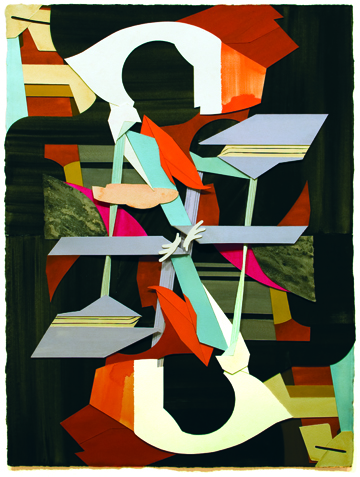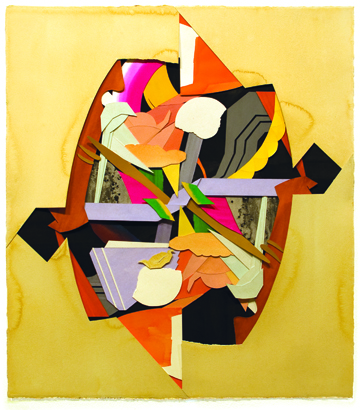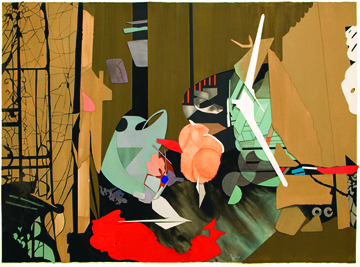Jim Gaylord, Call on the Carpet, 2013, gouache on cutout paper, 36 x 50 inches
courtesy of the artist and Jeff Bailey Gallery
CHRISTIAN MAYCHACK: I was thinking about the title of your last show with Gregory Lind, Skipping Over Damaged Area, and about that sort of technological breakdown that happens with the damaged area of a DVD, and it seems like that moment you’re picking is also about the fallibility of our perceptions, like we sort of smooth over that moment and don’t really notice it.
JIM GAYLORD: Right, and when that actually happens on a DVD you don’t see it at all. It’s missed and isn’t even perceived, but there is something very pertinent about the way we see moving images in cinema and television, where it’s a series of frames and our minds fill in the spaces to create the illusion of motion.
CM: It sort of happens in our day to day, too. Our peripheral vision is mostly made up of a smoothing over of details that we don’t really see, but we make sense of them narratively. Do you see that as something similar?
JG: I think we have to tune out a lot of that information in the periphery just in order to function. If we paid attention to every piece of visual stimulus detected by our eyes, we would go nuts. Part of what I’m interested in is the information in the periphery of understanding, where you think you know what you’re seeing just because there’s an intrinsic logic in the way it was put together, and a very deliberate specificity, but there’s no way to come up with a complete narrative. It just keeps turning itself over, leading you back to different parts of the image, so that you have to keep second-guessing your assumptions. There’s a kind of false sense of understanding in the initial perception and then you realize, “oh, I really don’t know what that is.”
CM: It seems with this work, you’ve stopped giving as many clues to a viewer about what things are.
JG: Yeah, I’ve really lost my interest in representation in painting. There was a phase when I was using realism as a way to counter the abstraction that I was playing with, and then the realism slowly disappeared because I realized there were two different languages trying to operate at the same time.
CM: Well, you let go of representation, but the way these things are cut out, they still can’t help but reference representation. I just went to see the Thomas Nozkowski show, and in that same way he’s sort of probing representation without actually going there, and I feel like your new work does that without going towards the object that was its source.
JG: Nozkowski is definitely an important reference. I often have difficulty with the idea of simply abstracting a representational image and making it into something else, which is why the film stills were interesting to me. I’m finding frames in these movies that are already abstract, so there’s something about them that’s more honest in a way, versus abstracting something from life. And Nozkowski is coming up with interesting relationships between forms that don’t necessarily come from observation, but there is something very bodily about the work in his two shows that are up right now. Something that I’ve often thought about with abstract painting is that people ultimately look for a figure.
CM: People can’t help but Rorschach.
JG: Right, and that ‘s a very relevant concept for me right now in terms of the symmetry that’s happening in some of the work. I was thinking about why a Rorschach image is symmetrical, and there seems to be a reference to the body—our bodies and faces are symmetrical, and we’re used to seeing symmetry in life. So, I think a Rorschach image is such a provocative psychological device, and makes sense to us on such an instinctive level, because of that. If we saw half of a Rorschach, it would just be meaningless blotches, but when there is order imposed on it via symmetry, our mind says that it’s something we should recognize, and we make the next leap.
The kind of symmetry that I’m working with isn’t reflective, but “point” symmetry, like you would see in a playing card. But there are portions that I obstruct with forms that aren’t referenced in the other half, so it is deliberately disrupted. Symmetry is sometimes too easy of a solution for a composition, so I’m grappling with it and trying to decide how it serves the work, as in the sense of rightness vis a vis the Rorschach concept.

Jim Gaylord, Mirror Repair, 2013, gouache on cutout paper, 30 x 22 inches courtesy of the artist and Jeff Bailey Gallery
CM: I think symmetry can really ground an image and make it static, but there is something about this process, the way you use collage that’s not flattened. All the pieces seem as if they could return to movement at any moment, which makes sense given that the source materials are stills from films. And your history with film—you went to school for film and studied animation, right? The symmetry doesn’t become static; it can operate both ways.
JG: It’s volatile. I think the surfaces of the cutout pieces are important. With the first one I did, I flattened it out completely and now I realize that it’s so much more interesting to leave the fragments popping out a little bit.
CM: They seem sort of theatrical to me in the way they used to light theater sets by candlelight, and they were painted in such a way that it would create movement. I see something similar in the way light reacts with the surfaces of these that gives them a theatricality.
JG: My first job ever was as a scenic painter for the theater, and I’ve actually thought about the possibility that some of these could be adapted as theatrical sets. I don’t know where that idea will go, but you’re right that there is something similar about the way sets are constructed, where there are a lot of flat planes in front of each other to create a sense of foreshortened space. For example, the old trick of the waves moving back and forth, so yeah, there’s something about the effect of each layer that’s kind of like that.

Jim Gaylord, Folk Eye, 2013, gouache on cutout paper, 30½ x 28 inches courtesy of the artist and Gregory Lind Gallery
























